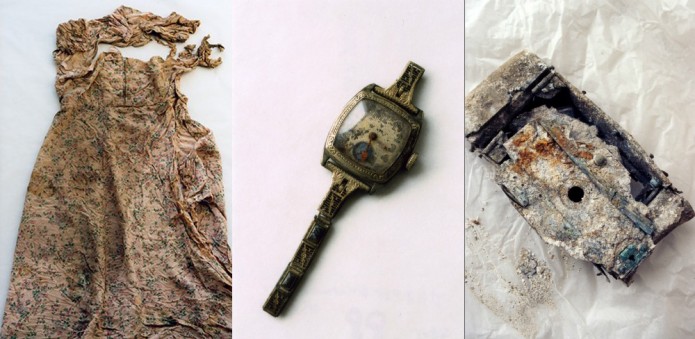Sometimes on the Neutron Trail I have experiences, which exist more in the realm of emotion and feeling than in linear thoughts. These experiences have a coherence of their own, before words, yet they yearn to be expressed and shared.
Tonight I had such an experience, viewing the Canadian premiere of Things Left Behind at the 2012 Vancouver International Film Festival (VIFF).
In this profoundly visual film, Linda Hoaglund expertly examines the role of artifact in meaning and also metabolism of experience. She opens it with a breath and continues at a natural pace.
We see Ishiuchi Miyako, Japanese photographer, walking into the Hiroshima Peace Memorial Museum to make images of atomic bomb victims’ personal belongings. In 2011, Miyako graced us here in Vancouver at the Museum of Anthropology (MOA) with her exhibit of these colorful, light–filled photos: ひろしま hiroshima.
I settled into the documentary’s contemplative rhythm, emotions flowing through me while I breathed it all in. MOA’s West Coast tribal totem poles echo visually through the film reminding us Hiroshima and Nagasaki’s hibakusha are not the only victims of our primal drive to vanquish other tribes and nations.
The scientists, during World War II, who alerted their governments to the potential to make atomic bombs, were themselves fleeing Hitler’s rein of terror. These same scientists built the first nuclear weapons, except for Heisenberg who stayed behind in a failed attempt to help the Nazi’s get there first. Meanwhile, in the South Pacific, Japan was conducting its own rein of terror, invading neighboring countries, raping and murdering by the millions. The Emperor went so far as to incite some 20,000 of its own citizens to commit suicide rather than risk surrender to the U.S. who he feared might have given the Japanese better treatment.
Don’t we all have either or both sides of this equation in our blood? Don’t we all yearn for the healing hinted at in Miyako’s haunting images of the atomic bomb victims of her country?
Hoaglund filmed the visitors to the MOA exhibition and included their expressions and responses to Ishiuchi’s images. Each comment, whether voiced in Japanese, English or Spanish, by a man, woman or little boy, touched me with both its unique character and universality.
Archivists from the Hiroshima and Vancouver museums guide us deeper with personal particulars. While viewing a boot with no laces, we hear the tragic story of its fourteen-year old owner, an atomic bomb survivor who only lived long enough to make it home.
MOA’s archivist converses with Miyako as she views the totem poles for the first time and Hoaglund punctuates the film with these delightful moments of spontaneous curiosity and discovery.
What is remarkable is we are now able to choose to witness these artifacts. We are able to examine our responses to the wounds they represent. We are able to feel sadness, shame, remorse and also light and love and perhaps forgiveness or reconciliation. I think it is this spirit of examination helping us to evolve past the primal drives to destroy or be destroyed.
In the Q&A after the film, Hoaglund mentioned total resistance, so far, in the U.S. to screening her film at festivals like VIFF. Last year, when I met Ishiuchi, she said museums in the U.S. had to that point refused the ひろしまhiroshima show. But tonight Hoaglund also said some 200 universities in the U.S. had bought the film.
I wrote the following poems and haiku a year ago in October after meeting Ishiuchi Miyako and viewing her photographs at the ひろしま Hiroshima exhibit, where much of the film was shot. I include them here as an alternate expression of my process as a viewer:
1. Meeting
Appreciating you the artist.
The matter of factness in your presence –
Gentle, squeeze of your hand,
Intelligent, kind gaze meeting mine.
Each on our way.
2. Things Left Behind ひろしま
(Ode to Ishiuchi)
Your communion with their
clothes could save us all.
You – like the mother bird
Pre-digesting food.
You ate the dark bitter
Hiroshima’s burnt kimono,
melted camera
blood-stained dress.
And left us each a pure
Choice.
To find the evidence of
sorrow or of
light.
In your photos, the clothes
weigh weightless
Each viewer left to tip the thing
Toward memory,
shock,
loss,
redemption or
Transformation.
A bit of ash
blackened, white tinged
wafting
upwards
on the flame’s heat,
Leaves smoke behind.
Still containing all the DNA
of its life in form.
Twists in the light wind
and then nothing
Only the blue sky
and a cool breeze.
Space
is refreshment.
Boundless Space
Open to all.
* * * * * * * * * * * * * * * * * * * * *
Haiku inspired by 3 photos in ひろしま hiroshima exhibit
1.
Flattened dusty crust –
Disintegrating viewer,
sees no more of you.
2.
Torn where it left her –
Zipper stays, sleeves blow away.
Small flowers blossom.
3.
Charred and golden –
Captivating gap dissolving,
Eight, nine, ten are gone.
* * * * * * * * * * * * * * * * * * * * *
If you like art, if you enjoy expertly crafted, aesthetically shot documentary, then Things Left Behind is a must see. Remaining VIFF 2012 screenings October 1 (12:20 p.m.) and October 12 (9:30 p.m.).
[This post was updated on Sept 29, 2012 at 10 am.]



 Twitter
Twitter
One Response to Reflections on ‘Things Left Behind’